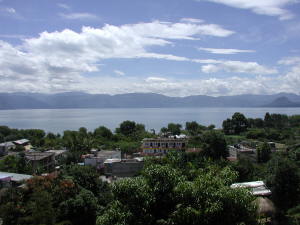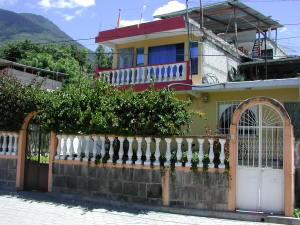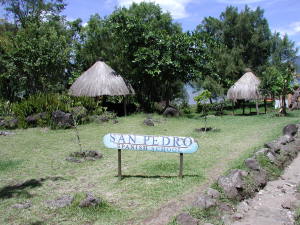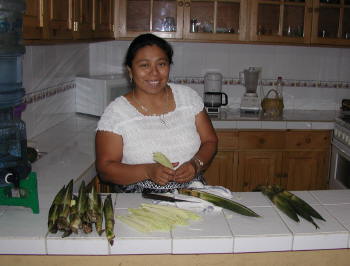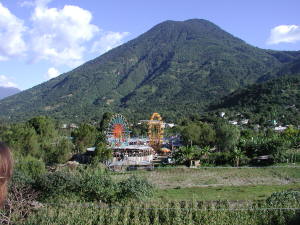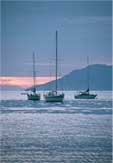
Logbook: Guatemala - San Pedro La Laguna, Lake Atitlan
June 16 - July 1, 2006
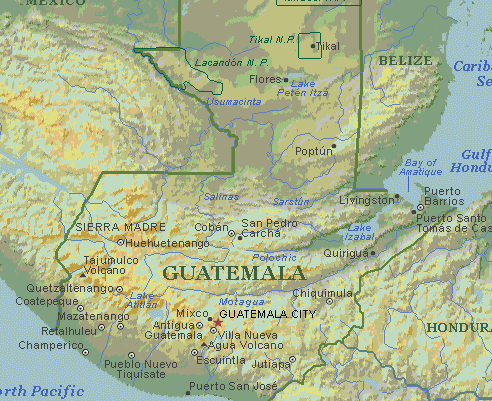 |
In mid-June, we traveled
inland to Guatemala, where we spent five weeks (June 16 to July 21).
The first two weeks, we attended Spanish School in San Pedro, Lake Atitlan, and
we spent the
next three weeks traveling throughout the country. This web page gives some background on Guatemala and covers our time in San Pedro. |
 |
Guatemala covers an area of 42,000 square miles (109,000 square kilometers); it's slightly bigger than the U.S. state of Ohio. Total population is 11.2 million, and over 50% of the people are indigenous Mayan. Although Spanish is the official language of Guatemala, there are over 20 separate (and often mutually unintelligible) Mayan languages.
Like most Central American countries, Guatemala has had a history of instability, but this country seems to have experienced some of the worst problems. Crime and corruption have been ruling forces in their government since their independence from Spain in 1847. Civil war broke out in 1960 and lasted 36 years, with 200,000 Guatemalans killed, a million left homeless and thousands who "disappeared." The war ended in 1996 with signing of peace accords, and the country is making progress, but it continues to be a rocky road.
Guatemala has also had its share of natural disasters. A 1976 earthquake killed about 22,000 people and left about a million homeless. (And, unfortunately, most of the aid sent to help the people in need never reached them.) Also, just last year, Hurricane Stan brought heavy rains, and mudslides wiped out entire villages. Some of the mudslides were attributed to deforestation, which is an environmental issue that faces this country. There is an awareness of the problem, but they are still working on an effective plan to control it.
Lawlessness and violent crime have been problems in this country, so one doesn't travel here without caution. Fortunately, in the past couple of years, several of the areas that want to attract tourism have taken steps to make it safer. Tourist Police forces have been organized, and they accompany tourists in areas that have historically been sites of robberies or assaults.
Roman Catholicism is still the predominant religion in Guatemala, but it appears to be losing ground to the Evangelical Protestant sects. The Evangelicals have been in Guatemala since the 1980's and their numbers are growing. We saw many Evangelical churches throughout Guatemala.
We hope that this country continues making progress because it has a lot to offer. The countryside is incredibly beautiful - it ranges from mountainous forest highlands with 30 volcanoes to jungle plains. The history of the Mayan people and the temple ruins are very intriguing. And, the people of Guatemala are some of the warmest and nicest we've ever met.
San Pedro La Laguna (Lake Atitlan) - 6/16-7/1
We have friends who attended Spanish School in San Pedro and highly recommended it. To get to San Pedro from San Salvador, we took a first-class bus (very nice!) to Guatemala City (4½ hours), then a chicken bus to Panajachel (3½ hours), then a lancha (water taxi) to San Pedro (about 20 minutes).
| When we arrived San Pedro, we found a hotel room with a view of the lake for our first couple of nights. Hotels are cheap here - we paid $10/night. Lake Atitlan is at the southern edge of a mountainous region referred to as the "highlands," and the residents of the highland areas are primarily Mayan. The lake reminded us a bit of Tahoe, with its surrounding mountains, but Atitlan is smaller and three of its mountains are volcanoes. |
|
San Pedro sits at 5,155 feet (1,562 meters) above sea level. If the sun was out, the days were warm, but not humid. Evenings were cool, and rainy days could be downright chilly. We had a mix of weather there - some rainy and some sunny days. San Pedro's population is about 8,000, mostly Mayan. Most of the women wear traditional clothing consisting of colorful woven skirts and embroidered blouses. Most of the men wear Western clothing, but we saw a few wearing traditional outfits. Many of the residents of San Pedro are members of the Evangelical churches.
San Pedro also has a number of residents from other countries, many of which are flashbacks to the 1960's hippies - they look, dress and act the part. Probably half of the restaurants in San Pedro are run by non-Guatemalans, and one can find a great variety of food here, from traditional rice and beans to French, Italian, Middle Eastern, Indian and American cuisines, and lots of vegetarian options. One unfortunate part of the presence of some of these folks is the presence of drugs, which concerns the local Mayans. We understand that there is a Mayoral election coming up, and one of the candidates is an Evangelical who wants to make San Pedro a dry town. It will be interesting to see what happens.
San Pedro's El Centro (downtown) is located on top of a hill. There are two main cobblestone streets leading into El Centro from the lake - one goes up the hill from the Principal Dock (where we arrived from Panajachel), and the other goes up the hill from the Santiago Dock (used by lanchas from Santiago, another town on the lake). The streets are very steep, and walking up and down the hills to El Centro was quite a workout, especially with the altitude. One would think that there would be another main street at the bottom of the hill connecting the Principal and Santiago Dock Streets, but not so. There is a "Main Trail" (a dirt trail) that runs between the two (about 1/2 mile), and there are several restaurants, hostels, schools and churches along the main trail. When it rained hard, the two main streets developed streams down the middle, and the main trail developed some big puddles. Fortunately the trail was pretty sandy, so it wasn't too muddy.
We arrived in San Pedro on a Friday, and on Saturday, we checked in at the San Pedro Spanish School and completed our registration for classes, which would start on Monday. As part of our immersion program, we chose to live with a local family while attending school. The total cost for two weeks of instruction, accommodations with a local family and three meals daily (except Sunday) was $208 per person - an incredible deal!
The next day, we moved in with the Mendez family - Cesilia, Antonio, Ruth (age 11) and MariElena (age 7) - whose home is about a 10 minute walk from school. Cesilia and Antonio are in their early 30's and have worked very hard at making a comfortable life for their family. They are originally from San Pedro, but for ten years, they lived in Guatemala City and worked in the home of an affluent family - Cesilia as live-in help and Antonio as a chauffeur. Three years ago, they moved their family back to San Pedro because they felt it was a better place to raise their girls. Until just a few months ago, however, Antonio continued to work in Guatemala City and came home on weekends. He is now driving a van for a local travel agency, so he works from San Pedro but still spends a fair amount of his time on the road. In addition to hosting Spanish students, Cesilia is a seamstress. Her parents own a clothing tienda, and she sews women's blouses to sell in their tienda. They have three sewing machines in their front room, and we've seen all four members of this family operating them. They also have a helper - Vicenta - who sews and watches after the girls if Cesilia and Antonio are away.
| The Mendez house was larger and more modern than we expected - 4 bedrooms and 2 bathrooms. We had a nice-sized bedroom on the second floor with a view of the lake and almost exclusive use of one of the bathrooms. They also had a roof-top porch where we could study, read or nap in a hammock. Their living/family room had a TV and stereo. Their furnishings were not brand new but they were certainly adequate and comfortable. The kitchen had a propane stove, microwave and coffee maker (to brew their delicious Guatemalan coffee) but no sink! We also did not have a sink in our bathroom. The city of San Pedro only pumps water to its residents one or two days/week. On those days, the family fills a reservoir from which they draw their water during the week. The reservoir water is plumbed through the house in the toilets and showers, but there was a common "sink" in an area we would describe as a "utility room." There, the family used plastic pans to dip water from the reservoir to do dishes. We also brushed our teeth, washed our faces and Rich shaved in this "utility room." We used bottled water to brush our teeth because the water provided by the city is not purified. |
|
|
|
We attended Spanish school for two weeks, from 8 a.m. to 12 noon each day. Instruction was one-on-one, and classes were held under thatched-roof palapas in a garden setting. It doesn't get much better than that! Rich's instructor was named Clara, and Jan's was Angelina. Both were excellent instructors, and we felt lucky that both were also good matches for us personality-wise. Clara joked that Rich was a little "perezoso" (lazy) and took it a little easier on him. Angelina pushed a bit harder on Jan. We both studied a lot of verb conjugations, and we'd come home with our list of verbs to memorize. Rich would have about 10, and Jan would have about 25. In addition to the formal instruction, we spent a lot of time just talking with our instructors. Clara and Angelina spoke slowly and clearly so that we could understand them, and they were very patient. We wish everyone spoke Spanish so slowly and clearly! One day, Angelina brought a board game to school. She and Jan each took a turn rolling a dice and moving a game piece along squares on the board. In each square was a question that needed to be answered in Spanish. Jan landed on a square asking about her favorite concert. You should have seen her trying to explain a Jimmy Buffett concert to Angelina! |
Afternoons, we often walked to the opposite end of the main trail, where we found a favorite bar, internet cafe and cafe for coffee. Nick's Bar sat next to the Principal Dock, and it was a popular place to go for a beer and cheap, good food. We were in San Pedro during the World Cup football (soccer) competition, and although we're not big professional sports fans, we got caught up in the excitement of this event. The games were aired at 2 p.m., so we could usually watch a game and then go for a coffee and/or check e-mail and do some studying.
In addition to classes, our school sponsored some other activities. Most evenings, for an hour, they offered a "Conversation Club" in which we spent time conversing and practicing our Spanish with other students. They grouped us according to experience level, and an instructor participated and guided the conversation by asking questions. Other school activities included salsa dancing lessons (Rich's favorite), a local museum tour, movies and presentations/orations by some locals. One of the presentations told us the Mayan folkloric tale of the creation of the world, which was a bit hard to grasp since the story was told in Spanish. The next week, a local man told us of his experiences when he was taken as a prisoner and tortured during the civil war. Fortunately, this time someone helped to interpret, and it was an incredibly moving story.
| While we attended school, Cesilia spoiled us at home. She not only cooked for us, but she did the dishes too! Most of our meals were simple and very typical (we ate a lot of beans), but they were very tasty, and a few times Cesilia prepared some special traditional meals. We tried some new vegetables - guisquil, pacaya and hierba - and we liked them all. Cesilia has a gregarious personality and was always happy to chat with us to help us practice our Spanish. When she called to someone in another room, her voice would boom out. We will always remember her call for a meal - "Janet! A comer!" Antonio was often away from the house working, but when we saw him, he was always friendly and outgoing. He appeared to be fairly athletic and enjoyed playing football (soccer) with the guys. Ruth and MariElena were typical kids, and their personalities were very different. Ruth is the more responsible one, and MariElena is mischievous but endearing. We played a few games of Dominoes with them, and Jan also played some Uno with the two girls. Jan got a bit frustrated, though, when the girls spoke Mayan to each other and plotted against her! The girls knew a few words in English, and Jan was very surprised one evening when MariElena said very sweetly "One moment, please." |
|
On the weekends, the school offered a couple of different excursions. Every Sunday, they sponsor a trip to Chichicastenanago, which hosts one of Guatemala's largest outdoor markets. We went one Sunday, and when we arrived in Chichi that morning, it was raining, so we stopped in a small local restaurant for breakfast. This was the best deal we've ever gotten on a meal. We each had a big plate of scrambled eggs, rice, beans, blue corn tortillas, bread and pinol (a tea made from corn) - all for about $1.35/person. Although we're not big shoppers, we enjoyed the Chichi market more than we thought we would and couldn't resist buying a few souvenirs and gifts. On one Saturday, the school organized a hike to "Nariz del Indio" (the Indian nose). The day was clear and sunny and offered oustanding views of the lake. There was a good group of people who did the hike, several of whom we had gotten to know from school and the conversations clubs, so we really enjoyed that day.
| Another Saturday, we wanted to hike San Pedro Volcano, which is an ecological park and a protected area. The volcano rises to almost 10,000 feet - what were we thinking??? Antonio arranged a guide for us, which is recommended for security reasons. A friend of his met us at their house at 6 a.m. and walked us to the park entrance, which was 40 minutes uphill. The hike up the volcano was tough. The trail was very steep - in some areas there were steps, but there were no switchbacks. We aren't in as good of shape as we used to be and with the altitude, Jan was gasping for air. It didn't seem to bother Rich as much. We hiked to about 20 minutes short of the top. We didn't finish the climb because the weather was deteriorating - clouds had rolled in, wiping out the view and rain was on the way. On our way down, it started raining and the trails became very slippery with streams of water filling our hiking boots. We arrived at the bottom 7 hours after we started the hike, tired, sore and muddy. Although the hike was arduous, and we missed some of the views because of the clouds, the flora along the trails was beautiful, and it was another adventurous day. |
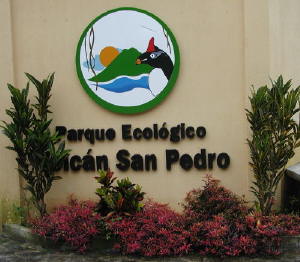 |
|
|
During our stay in San Pedro, the
town celebrated the feast of it's patron saint, Saint Peter, which is on June
27. The fiesta started a week before and was still going on when we
left on July 1. They celebrated with parades, a fair area set up with
games and rides (2 ferris wheels), lots of music and firecrackers. The
firecrackers were set off both during the day and in the middle of the night. Music would often start early in the
morning (4 a.m. one day) or last very late (2 or 3 a.m.), and it was played loud
enough to keep at least half the town awake. Jan tried earplugs, but even
they didn't help much. Although we enjoyed the parades and the festive
atmosphere, if we had to do it over again, we would avoid this celebration. We
preferred the quiet village ambiance that we experienced when we first
arrived.
|
One of the things we liked best about San Pedro was its people. The locals seemed to appreciate and enjoy having students in their town, and they went out of their way to make us feel welcome. When we walked down the street (or the main trail), we needed to pay attention and greet the locals because they would always greet us. These were some of the nicest and friendliest people we've ever met. Some of our favorite locals were the young girls who sold bread. For 65¢, they sold cinnamon rolls, and coconut, carrot, pineapple and chocolate breads. Rich became good friends with a little girl Angela who sold him bread every day during our break from school. There was another young girl named Flora who stole Jan's heart.
During our last few days in San Pedro, our friends Pat and Carrie (s.v. Terra Firma) showed up. They had been traveling through Guatemala for several weeks and were near the end of their trip. Since we were just starting our travels, we were eager to get their impressions and input on places to go and sites to see. We had lots to talk about while we shared some drinks and meals.
Our two weeks in San Pedro flew by. Although we learned a lot in Spanish school, two weeks was not nearly enough. We've got so much more to learn! Our stay with the Mendez family was very special, and Jan was fighting back tears when we hugged them good-bye. We also met a number of interesting travelers here, from all over the world, and several of whom we ran into again as we continued to travel throughout Guatemala.
